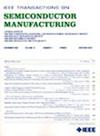Fast and High-Precision Temperature Control in Semiconductor Vertical Furnace via Iterative Experiments
IF 2.3
3区 工程技术
Q2 ENGINEERING, ELECTRICAL & ELECTRONIC
引用次数: 0
Abstract
The semiconductor vertical furnace is a key component in semiconductor manufacturing, used for heat treatment processes such as oxidation, layer deposition, and annealing. Improving the speed of temperature control in this equipment is critical for increasing productivity, particularly by shortening the time required for large temperature changes, known as thermal ramps. Although modeling a linear time-invariant (LTI) system is effective around a fixed operating temperature, it becomes inaccurate during rapid heating and cooling processes that involve large temperature changes, especially when faster control performance is required. As a result, conventional model-based control methods often fail to deliver both fast and accurate temperature regulation in practical scenarios. The aim of this paper is to develop a data-driven approach that enables high-speed, high-precision temperature control in a semiconductor vertical furnace. The proposed method is based on an iterative experimental procedure that refines the control model using actual measurement data. Experimental results show that the approach achieves the target temperature accurately within just four iterations. Compared to the conventional Linear-Quadratic-Gaussian (LQG) control method, it reduces the settling time to within ±1°C of the setpoint by 18% and lowers energy consumption by 20%. These findings demonstrate that the proposed data-driven method enables faster, more accurate, and more energy-efficient temperature control in semiconductor vertical furnaces.基于迭代实验的半导体垂直炉快速高精度温度控制
半导体垂直炉是半导体制造中的关键部件,用于氧化、层沉积和退火等热处理工艺。提高该设备的温度控制速度对于提高生产率至关重要,特别是通过缩短大温度变化所需的时间,即热斜坡。虽然线性时不变(LTI)系统在固定的工作温度下建模是有效的,但在涉及大温度变化的快速加热和冷却过程中,特别是在需要更快的控制性能时,它变得不准确。因此,传统的基于模型的控制方法往往无法在实际场景中提供快速准确的温度调节。本文的目的是开发一种数据驱动的方法,使半导体垂直炉的高速、高精度温度控制成为可能。所提出的方法是基于一个迭代实验过程,利用实际测量数据来改进控制模型。实验结果表明,该方法仅需4次迭代即可准确地获得目标温度。与传统的线性二次高斯(LQG)控制方法相比,它将沉降时间缩短到设定值±1°C以内,降低了18%,能耗降低了20%。这些发现表明,所提出的数据驱动方法可以在半导体垂直炉中实现更快,更准确,更节能的温度控制。
本文章由计算机程序翻译,如有差异,请以英文原文为准。
求助全文
约1分钟内获得全文
求助全文
来源期刊

IEEE Transactions on Semiconductor Manufacturing
工程技术-工程:电子与电气
CiteScore
5.20
自引率
11.10%
发文量
101
审稿时长
3.3 months
期刊介绍:
The IEEE Transactions on Semiconductor Manufacturing addresses the challenging problems of manufacturing complex microelectronic components, especially very large scale integrated circuits (VLSI). Manufacturing these products requires precision micropatterning, precise control of materials properties, ultraclean work environments, and complex interactions of chemical, physical, electrical and mechanical processes.
 求助内容:
求助内容: 应助结果提醒方式:
应助结果提醒方式:


